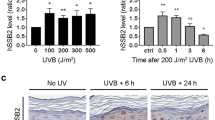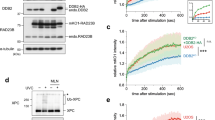Abstract
HUMAN replication protein (RPA) functions in DNA replication1-4, homologous recombination5 and nucleotide excision repair6. This multisubunit single-stranded DNA-binding protein1,2 may be required to make unique protein-protein contacts because heterol-ogous single-stranded binding proteins cannot substitute for RPA in these diverse DNA transactions5-7. We report here that, by using affinity chromatography and immunoprecipitation, we found that human RPA bound specifically and directly to two excision repair proteins, the xeroderma pigmentosum damage-recognition protein XPA (refs 8, 9) and the endonuclease XPG (refs 10-13). Although it had been suggested that RPA might function before the DNA synthesis repair stage14,15, our finding that a complex of RPA and XPA showed a striking cooperativity in binding to DNA lesions indicates that RPA may function at the very earliest stage of excision repair. In addition, by binding XPG, RPA may target this endonuclease to damaged DNA.
This is a preview of subscription content, access via your institution
Access options
Subscribe to this journal
Receive 51 print issues and online access
$199.00 per year
only $3.90 per issue
Buy this article
- Purchase on Springer Link
- Instant access to full article PDF
Prices may be subject to local taxes which are calculated during checkout
Similar content being viewed by others
References
Wold, M. S. & Kelly, T. J. Proc. natn. Acad. Sci. U.S.A. 85, 2523–2527 (1988).
Fairman, M. P. & Stillman, B. EMBO J. 7, 1211–1218 (1988).
Kenny, M. K., Lee, S.-H. & Hurwitz, J. Proc. natn. Acad. Sci. U.S.A. 86, 9757–9761 (1989).
Kenny, M. K., Schlegel, U., Furneaux, H. & Hurwitz, J. J. biol. Chem. 265, 7693–7700 (1990).
Moore, S. P., Erdile, L., Kelly, T. & Fishel, R. Proc. natn. Acad. Sci. U.S.A. 88, 9067–9071 (1991).
Coverley, D. et al. Nature 349, 538–541 (1991).
Brill, S. J. & Stillman, B. Nature 342, 92–95 (1989).
Tanaka, K. et al. Nature 348, 73–76 (1990).
Robin, P., Jones, C. J., Biggerstaff, M., Lindahl, T. & Wood, R. D. EMBO J. 10, 3913–3921 (1991).
O'Donovan, A. & Wood, R. D. Nature 363, 185–188 (1993).
Scherly, D. et al. Nature 363, 182–185 (1993).
O'Donovan, A., Davies, A. A., Moggs, J. G., West, S. C. & Wood, R. D. Nature 371, 432–435 (1994).
O'Donovan, A., Scherly, D., Clarkson, S. G. & Wood, R. D. J. biol. Chem. 269, 15965–15968 (1994).
Coverley, D., Kenny, M. K., Lane, D. P. & Wood, R. D. Nucleic Acids Res. 20, 3873–3880 (1992).
Shiviji, M. K. K., Kenny, M. K. & Wood, R. D. Cell 69, 367–374 (1992).
Henricksen, L. A., Umbricht, C. B. & Wold, M. S. J. biol. Chem. 269, 11121–11132 (1994).
Jones, C. J. & Wood, R. D. Biochemistry 32, 12096–12104 (1993).
Aboussekhra, A. & Wood, R. D. Curr. Opin. Genet. Dev. 4, 212–220 (1994).
Clugston, C. K., McLaughlin, K., Kenny, M. K. & Brown, R. Cancer Res. 52, 6375–6379 (1992).
Bardwell, A. J. et al. Molec. cell. Biol. 14, 3569–3576 (1994).
He, Z., Brinton, B. T., Greenblatt, J., Hassell, J. A. & Ingles, C. J. Cell 73, 1223–1232 (1993).
Li, R. & Botchan, M. R. Cell 73, 1207–1221 (1993).
Dutta, A., Ruppert, J. M., Aster, J. C. & Winchester, E. Nature 365, 79–82 (1993).
Li, L., Elledge, S. J., Peterson, C. A., Bales, E. & Legerski, R. J. Proc. natn. Acad. Sci. U.S.A. 91, 5012–5016 (1994).
Park, C.-H. & Sancar, A. Proc. natn. Acad. Sci. U.S.A. 91, 5017–5021 (1994).
Longhese, M. P., Plevani, P. & Lucchini, G. Molec. cell. Biol. 14, 7884–7890 (1994).
Ingles, C. J., Shales, M., Cress, W. D., Triezenberg, S. J. & Greenblatt, J. Nature 351, 588–590 (1991).
Erdile, L. F., Heyer, W.-D., Kolodner, R. & Kelly, T. J. J. biol. Chem. 266, 12090–12098 (1991).
Erdile, L. F., Wold, M. S. & Kelly, T. J. J. biol. Chem. 265, 3177–3182 (1990).
Wang, Z. et al. Nature 368, 74–76 (1994).
Author information
Authors and Affiliations
Rights and permissions
About this article
Cite this article
He, Z., Henricksen, L., Wold, M. et al. RPA involvement in the damage-recognition and incision steps of nucleotide excision repair. Nature 374, 566–569 (1995). https://doi.org/10.1038/374566a0
Received:
Accepted:
Issue Date:
DOI: https://doi.org/10.1038/374566a0
This article is cited by
-
Airway epithelial cGAS inhibits LPS-induced acute lung injury through CREB signaling
Cell Death & Disease (2023)
-
XPG: a multitasking genome caretaker
Cellular and Molecular Life Sciences (2022)
-
Depletion of NK6 Homeobox 3 (NKX6.3) causes gastric carcinogenesis through copy number alterations by inducing impairment of DNA replication and repair regulation
Oncogenesis (2021)
-
Enhancer of mRNA Decapping protein 4 (EDC4) interacts with replication protein a (RPA) and contributes to Cisplatin resistance in cervical Cancer by alleviating DNA damage
Hereditas (2020)
-
Protein arginine methylation: an emerging regulator of the cell cycle
Cell Division (2018)
Comments
By submitting a comment you agree to abide by our Terms and Community Guidelines. If you find something abusive or that does not comply with our terms or guidelines please flag it as inappropriate.



